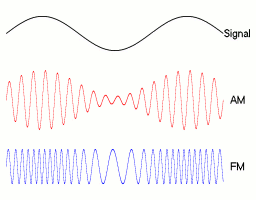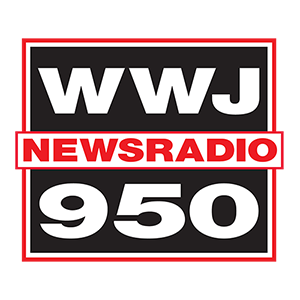
AM broadcasting is radio broadcasting using amplitude modulation (AM) transmissions. It was the first method developed for making audio radio transmissions, and is still used worldwide, primarily for medium wave transmissions, but also on the longwave and shortwave radio bands.
The British Broadcasting Company Limited (BBC) was a short-lived British commercial broadcasting company formed on 18 October 1922 by British and American electrical companies doing business in the United Kingdom. Licensed by the British General Post Office, its original office was located on the second floor of Magnet House, the GEC buildings in London and consisted of a room and a small antechamber.

It is generally recognized that the first radio transmission was made from a temporary station set up by Guglielmo Marconi in 1895 on the Isle of Wight. This followed on from pioneering work in the field by a number of people including Alessandro Volta, André-Marie Ampère, Georg Ohm and James Clerk Maxwell.

Charles David "Doc" Herrold was an American inventor and pioneer radio broadcaster, who began experimenting with audio radio transmissions in 1909. Beginning in 1912 he apparently became the first person to make entertainment broadcasts on a regular schedule, from his station in San Jose, California.

WGY is a commercial radio station licensed to Schenectady, New York, carrying a news/talk format which is simulcast full-time over WGY-FM. Owned by iHeartMedia, the station serves Albany, Troy and the Capital District of New York, and is a clear-channel station with extended nighttime range. WGY is one of the first stations in the United States and the oldest to operate continuously in New York State, having launched on February 20, 1922.

WWJ is a commercial AM radio station licensed to serve Detroit, Michigan, featuring an all-news format known as "Newsradio 950 WWJ". Owned by Audacy, Inc., the station services Metro Detroit, is the market affiliate for CBS News Radio, and the flagship station for the Michigan Sports Network. Operating on a regional broadcast frequency, its studios are in the Panasonic Building in Southfield.

KDKA is a Class A, clear channel, AM radio station, owned and operated by Audacy, Inc. and licensed to Pittsburgh, Pennsylvania, United States. Its radio studios are located at the combined Audacy Pittsburgh facility in the Foster Plaza on Holiday Drive in Green Tree, and its transmitter site is at Allison Park. The station's programming is also carried over 93.7 KDKA-FM's HD2 digital subchannel, and is simulcast on FM translator W261AX at 100.1 MHz.

WRUC is an independent educational college radio station, owned and operated by Union College in Schenectady, New York. The station transmits with an effective radiated power of 100 watts, providing coverage over an approximate 15-mile radius. WRUC also streams its programming on Internet radio. The station's offices and studios are located in the Reamer Campus Center on the Union College campus.
The Broadcasting Company of America (BCA) was a short-lived subsidiary of the American Telephone & Telegraph Company (AT&T). It was formed in May 1926 in order to consolidate AT&T's radio station and network operations into a single organization. However, just two months later AT&T announced that the subsidiary was being sold to the Radio Corporation of America (RCA). This sale took place on November 1, 1926, and RCA reorganized the BCA assets to form the core of National Broadcasting Company's (NBC) network operations, including its "Red Network".
WCAO is a commercial radio station in Baltimore, Maryland. It broadcasts an urban gospel radio format and is owned by iHeartMedia, Inc. It also airs some Christian talk and teaching programs. The studios and offices are located at The Rotunda shopping center in Baltimore.

Telephone Newspapers, introduced in the 1890s, transmitted news and entertainment to subscribers over telephone lines. They were the first example of electronic broadcasting, although only a few were established, most commonly in European cities. These systems predated the development, in the 1920s, of radio broadcasting. They were eventually supplanted by radio stations, because radio signals could more easily cover much wider areas with higher quality audio, without incurring the costs of a telephone line infrastructure.

The Telefon Hírmondó was a "telephone newspaper" located in Budapest, Hungary, which, beginning in 1893, provided news and entertainment to subscribers over telephone lines. It was both the first and the longest surviving telephone newspaper system, although from 1 December 1925 until its termination in 1944 it was primarily used to retransmit programmes broadcast by Magyar Rádió.

Théâtrophone was a telephonic distribution system available in portions of Europe that allowed the subscribers to listen to opera and theatre performances over the telephone lines. The théâtrophone evolved from a Clément Ader invention, which was first demonstrated in 1881, in Paris. Subsequently, in 1890, the invention was commercialized by Compagnie du Théâtrophone, which continued to operate until 1932.
KZY was a radio station located in Oakland, California, that was licensed to the Atlantic-Pacific Radio Supplies Company from December 9, 1921, until its deletion on January 24, 1923. It, and the Preston D. Allen station, KZM, were the first broadcasting stations licensed to Oakland.
Radio station 2XG, also known as the "Highbridge Station", was an experimental radio station located in New York City and licensed to the De Forest Radio Telephone and Telegraph Company from 1915 to 1917 and 1920 to 1924. In 1916, it became the first radio station employing a vacuum-tube transmitter to make news and entertainment broadcasts on a regular schedule, and, on November 7, 1916, became the first to broadcast U.S. presidential election returns by spoken word instead of by Morse code.
WDY was an AM radio station located in Roselle Park, New Jersey, that was licensed to the Radio Corporation of America (RCA) from September 19, 1921, to February 20, 1923, although its broadcasting career only spanned the period from December 15, 1921, through February 17, 1922. Despite being short-lived, WDY was the first broadcasting station licensed in the state of New Jersey, and one of the first in the United States. It also marked RCA's entrance into the broadcasting field, which the company would dominate in the U.S. for the next half century.
WMAF, known as "The Voice From Way Down East", was a radio broadcasting station licensed to "Colonel" Ned Green's Round Hills Radio Corporation in South Dartmouth, Massachusetts from September 1922 until 1931. In the summer of 1923 it began rebroadcasting programs originating from station WEAF in New York City, which is generally considered to be first sustained radio network connection in the United States.

WMH was a Cincinnati, Ohio AM radio station, which was licensed to the Precision Equipment Company from December 30, 1921, to December 11, 1923, although it ceased broadcasting in early January 1923. It was the one of the first formally authorized broadcasting stations in the United States, and also the first licensed in the state of Ohio.
WDM was an AM radio station, licensed to Church of the Covenant in Washington, D.C., which was issued its first license in December 1921, and went silent in mid-1925. It was also the first broadcasting station to be operated by a church.
WOO was an AM band radio station, which was operated by the Wanamaker Department Store in Philadelphia, Pennsylvania, from early 1922 until mid-1928.












